What is a 1-2-2 Zone Defense?
A 1-2-2 zone defense is a mix of some of the advantages of the 2-3 zone and 1-3-1 zone defense. The 1-2-2 zone has the ability to extend out and put pressure on the ball as well as having certain trapping areas. Even as it extends out to pressure more, the zone has good rim protection by keeping a player on each block. The 1-2-2 zone is built to match up naturally with a single guard on top and two wing players. This natural setup helps to keep the defense from breaking down.
The setup of the 1-2-2 zone has one defender on top picking up the ball around half-court. Two defenders start on each elbow. They are responsible for the wing areas and high post.
The last two defenders start on each block. Their area of zone is from the opposite block all the way to the corner where they start from. This defense helps to split the floor across into 3 levels and each section guards their 3rd of the cross section of the court.
There is a distinction I make between a 1-2-2 zone and a 3-2 zone. The point man in a 3-2 zone will follow the ball and cover the ball side block when the ball is in the corner. In a 1-2-2 zone, the point man stays at the hi-post when the ball is in the corner. This subtle difference keeps the confusion between the two defenses at a minimum.
If I want the 1-2-2 zone to look like a 3-2 zone , then I will call a 1-2-2 flat meaning the top 3 players will be flat across the zone. Likewise, if I want the point man to extend out of a 3-2 then I will call it a 3-2 extend but the point rotations stay the same. In all 1-2-2 zone variations the point man stays high. In all 3-2 zone variations the point man follows the ball.
Advantages of a 1-2-2 Zone
1. Ability to Pressure With Rim Protection
The 1-2-2 zone is a mix of the 2-3 zone and 1-3-1 zone by taking parts of both defenses. The 2-3 zone has trouble pressuring the ball. The 1-3-1 zone has trouble protecting the rim with a big. The 1-2-2 zone fixes both of those problems.
The extended front man is able to go out and pressure the ball as far up the court as the coach wants. But the 1-2-2 zone also has two defenders on the blocks. This gives added rim protection if the offense can get close to the basket. These two defenders help rebounding which can be difficult with 1-3-1 zone as well.
The 1-2-2 zone can also trap the ball in all areas of the floor. Even if the 1-2-2 zone becomes a trapping defense, there will still always be a big around the basket. Again, the 1-2-2 zone does a really good job of pressuring the ball with or without trapping but still keeps a rim protector around the basket at all times as well. This mix of pressure out front and coverage around the basket makes the 1-2-2 zone a good zone defense.
2. Can Be Aggressive or Passive
The 1-2-2 zone has the ability to morph from a passive defense to an aggressive defense without changing the overall defense. It can be played by guarding the ball with just one defender and everybody else is playing behind the ball. It also can be aggressive and trapping looking to create turnovers.
The versatility of the 1-2-2 zone helps teams be productive with their practice time. The same principles and rotations must be taught only once which saves time. Then the adjustments of when and how to trap are added which is a lot quicker than having to teach and learn an entirely new defense.
3. Guards the 3-point Line Well
The 1-2-2 zone helps to keep defenders out of the lane which means the 3-point line will have defensive coverage everywhere. The zone splits the 3-point line into 5 different sections and each defender is responsible for one of those sections. In a 2-3 zone or 1-3-1 zone, the 3-point line is guarded by only 4 defenders so each one of those defenders has more of the 3-point line to guard. By adding the 5th defender, the amount of the 3-point line responsible for each defender gets shrunk. So, the defense can guard the 3-point line much better than some other zone defenses.
Disadvantages of a 1-2-2 Zone
1. Opens the Middle of the Floor
With the benefits of the 1-2-2 zone also come the drawbacks. The ability to pressure the ball and still have rim protection is going to give something back to the offense. The offense gets the benefit of being able to get the ball into the middle of the zone much easier than a 2-3 zone or 1-3-1 zone.
Most coaches design zone offenses to get the ball into the middle of the zone. The 1-2-2 zone opens this area of the zone even more. The hi-post does not have a defender assigned to it. The two wings and point man of the 1-2-2 zone shift in and out of the hi-post to defend this area. This shifting gives the offense a chance to manipulate the defense by moving the ball around making the hi-post area less guarded. Then the offense can get the ball into the hi-post to turn and attack the basket.
This is the single biggest disadvantage of the 1-2-2 zone. If the defense can take away the hi-post, then the defense works well. If the defense cannot keep the ball out of the hi-post, then the offense should have plenty of opportunities to attack the interior of the zone and should lead to easy baskets.
2. Creates Natural Driving Lanes
The 1-2-2 zone is spaced out decently for a defense. Since the 1-2-2 zone does not have a middleman, once a defender is beaten there might not be anybody right there to help. So, the middle of floor can be attacked both by pass like disadvantage #1 and with the dribble.
The setup of the 1-2-2 zone has the space in between each two defenders that can give the offense enough space to attack with the dribble into these open areas. And these areas are not hard for the offense to get into. They are open by the setup of the 1-2-2 zone.
The first two driving lanes are in between the wings and the top man of the 1-2-2 zone. This lane, if split puts the driver at the foul line. This is a very dangerous and difficult spot to guard for the 1-2-2 zone.
The 2nd lanes are in between the wings and the bottom defenders of the defense. This puts the driver at the mid-post. Again, a dangerous and difficult spot to guard. Since the 1-2-2 zone does not have somebody in the middle, if the ball is driven into these gaps, then the defense must scramble and stop the ball in spots where it is not designed to do.
3. Rotations can be Long
Since the spacing of the 1-2-2 zone is designed to get out to the 3-point line and each player has a section of the 3-point line they are guarding, the rotations can be long. For instance, the bottom two players have the opposite block all the way out to the ballside 3-point line to guard.
So, if they are guarding the ball in the corner and a skip pass is made to the opposite wing, they are now the defender behind the now ballside post. That is a long run for any player to make. That is covering over half the width of the court on a possible skip pass to post entry.
Ballside penetration and skip passes are the two problem areas of the 1-2-2 zone. The defense is not designed to handle those two things. If a defense can prevent dribble penetration and cover the ground during a skip pass, then it is a great defense. However, at the high school and lower levels, the speed of the players can be a detriment to playing this defense.
Positions of a 1-2-2 Zone

This is the initial setup of the 1-2-2 zone. The point(1) is out in front of the defense putting pressure on the ball as soon as it crosses into the half-court. The wings(2 and 3) are on the elbows. They are working together to cover both wings and the high post. The high post is the most important so one of them will squeeze the foul line while the other one will extend out to the wing. The two bigs(4 and 5) start on the block.

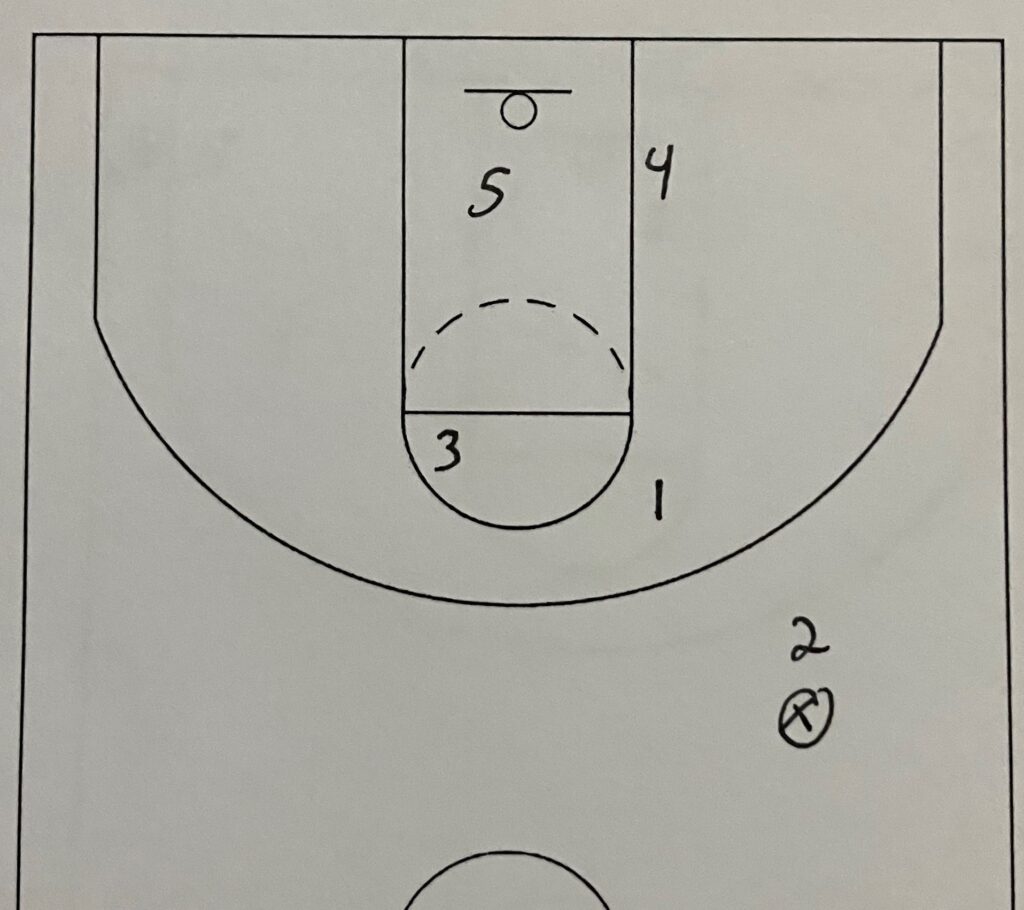
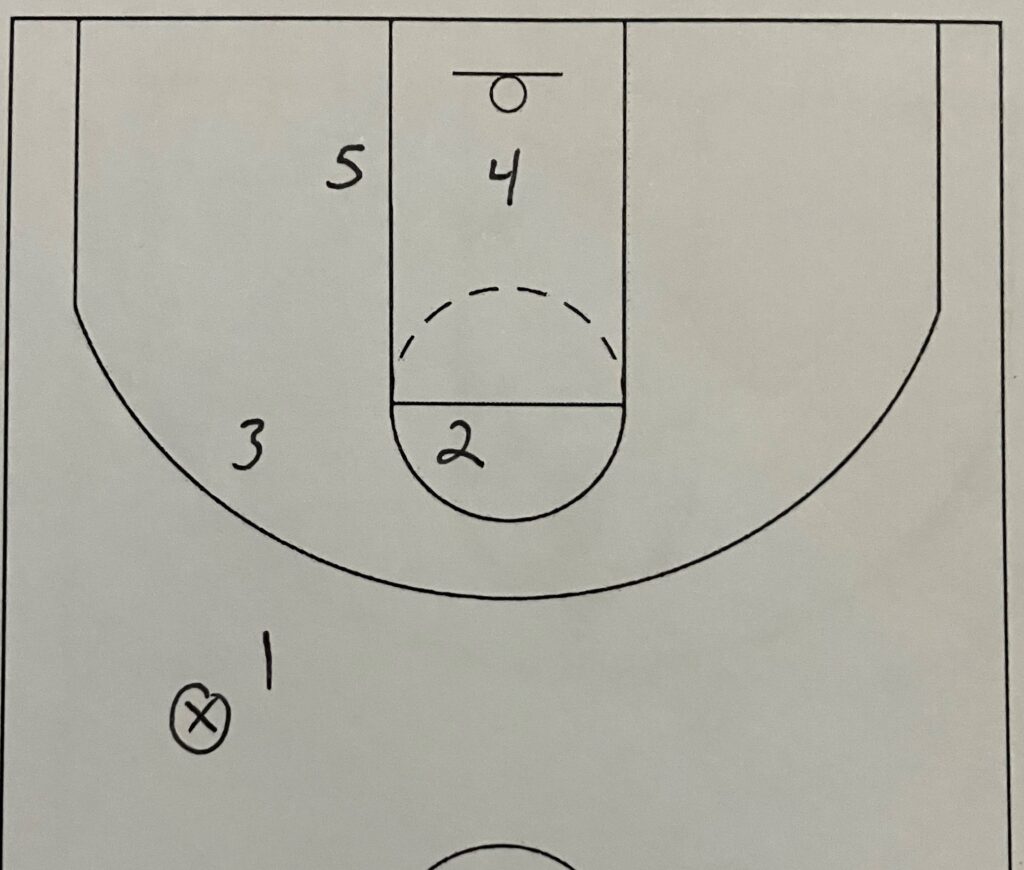

If the defense is not trying to trap then when the ball is on the top but to one side, the team has to make a decision on who is going to guard the ball in this spot. As you can see above, there are two options for this spot. The two pictures on the left have the point(1) guard the ball in this spot.
Personally, I prefer the point taking the ball in this spot. The other four players on defense stay in spots that are more threatening for the offense to score. The only problem is a pass to the top forcing the backside wing to step up and then a reversal to that wing. Since the backside wing has to step to the top, this could leave the wing spot open. To counter this, as you can see from the diagrams, I have put the point(1) shading the middle to try and keep the ball from going back to the middle.
The second option is to have the wing(2 or 3) step up and guard the ball. This keeps the point(1) at the top of the key but it opens the wing. If the ball is passed to the wing then the bottom(4 or 5) will need to step up until the wing recovers. If the bigs have to step up then it opens space near the basket. Having the wing step up this high creates too much space on the sideline and requires much more shifting and adjusting than having the point(1) still guard the ball this high.

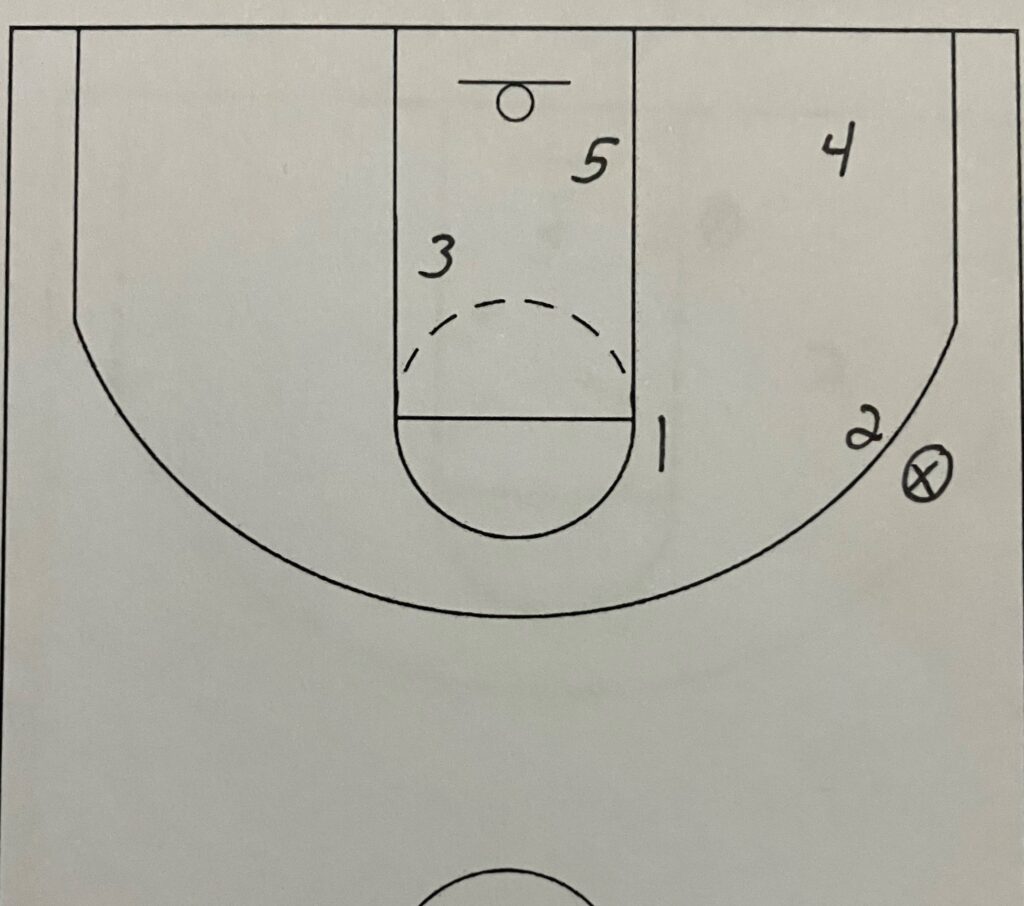
As the ball works its way down into the wing area where it is more of a scoring threat, the defense takes a much better shape. The wing(2 or 3) is picking up the ball and guarding it. The backside wing is dropping to the block/mid-post area. The backside wing is responsible for the backside rebound.
The point(1) is dropping into the high post area. The point(1) must stay disciplined in this spot. If they do not sprint back into the high post area then a quick pass to the wing then high post leaves an offensive player wide open at the foul line. The point(1) must get to the high post quickly and not try to sneak out for a steal on a reversal pass. If the point(1) is not at the high post area when the ball is on the wing, the 1-2-2 zone will not work.
The bigs(4 and 5) are going to slide towards the ball. The ballside big is splitting the difference between a corner man and a post man. If one of these spots are not occupied by the offense then the bigs can stay either on the block or out in the corner. The backside big is sliding to the ballside block. This backside big is covering the ballside block whether an offensive player is there or not. This big is the rim protector on any ballside drive.
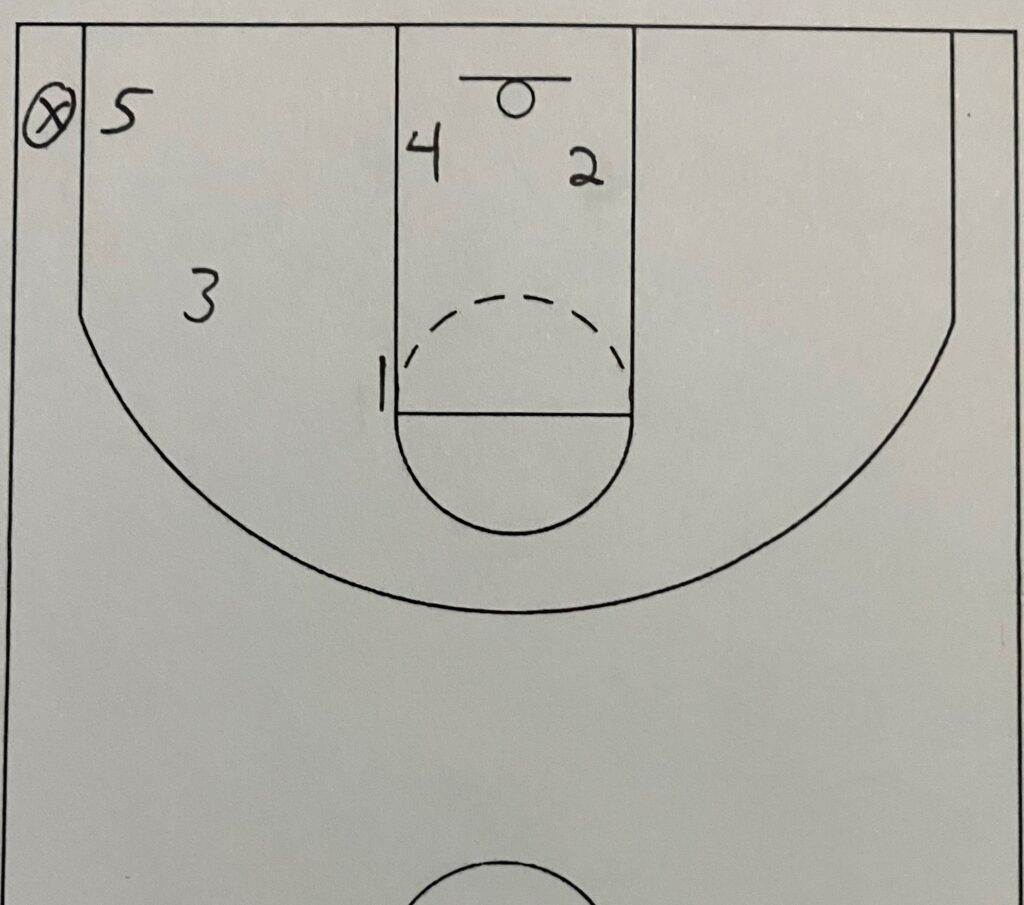

If the ball enters the corner, there is not much adjustment from when the ball was on the wing. The ballside big(4 or 5) is guarding the ball. The backside big is covering the block area. The point(1) is still in the high post area taking away any player entering the high post. The ballside wing(2 or 3) is dropping into a help position for a possible middle drive. The backside wing(2 or 3) is dropping to the backside block. They are covering any skip pass out of the corner. They are also responsible for any backside rebound. The 1-2-2 zone is nice in that the wing and corner rotations are pretty much the same for everybody on the floor.
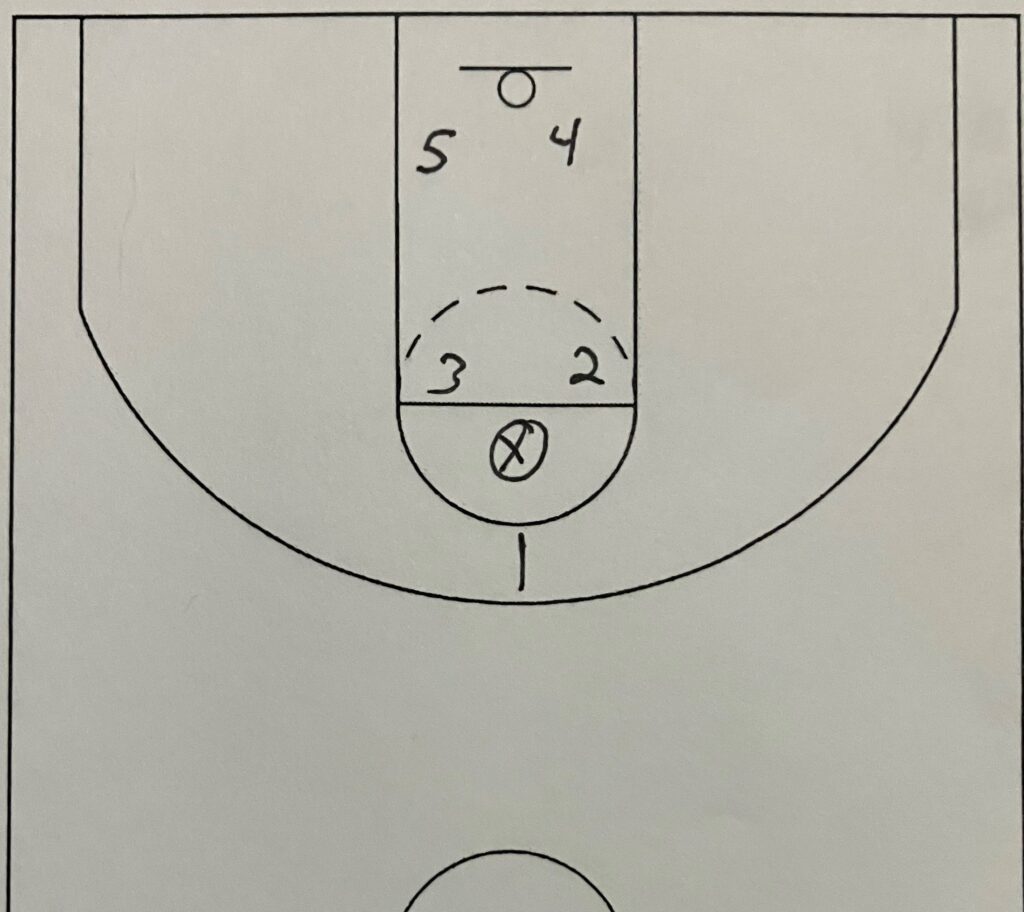
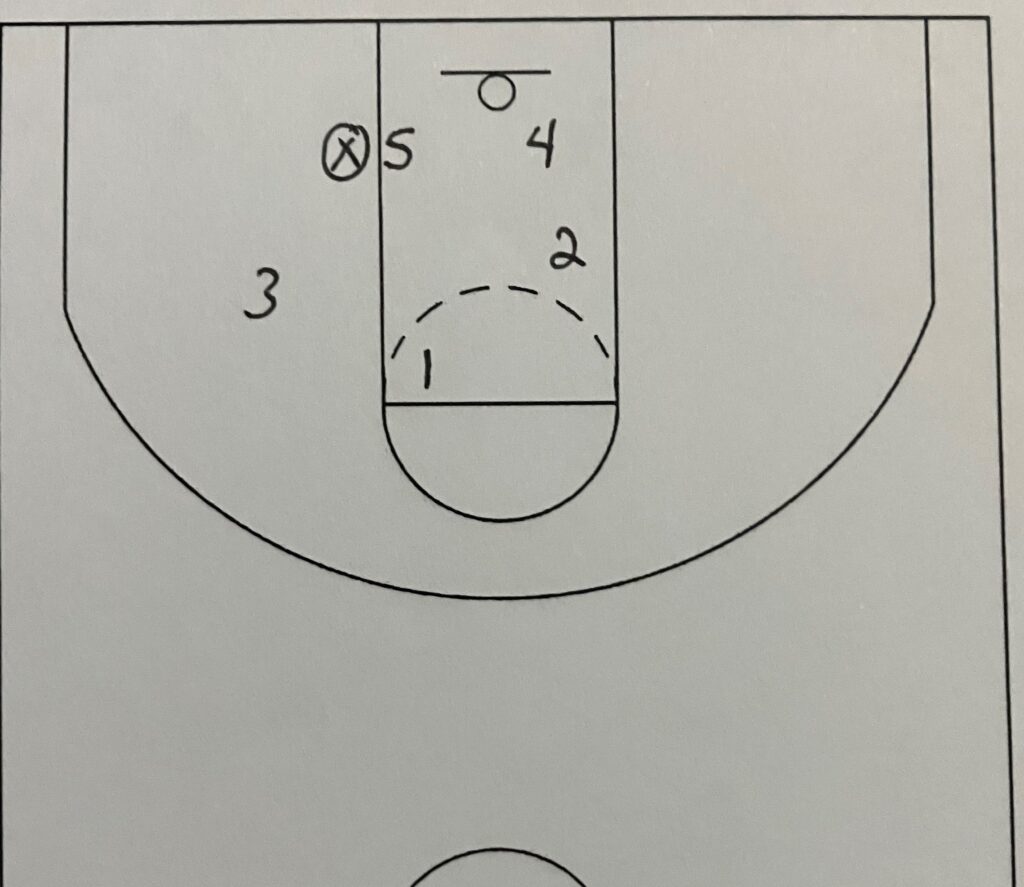
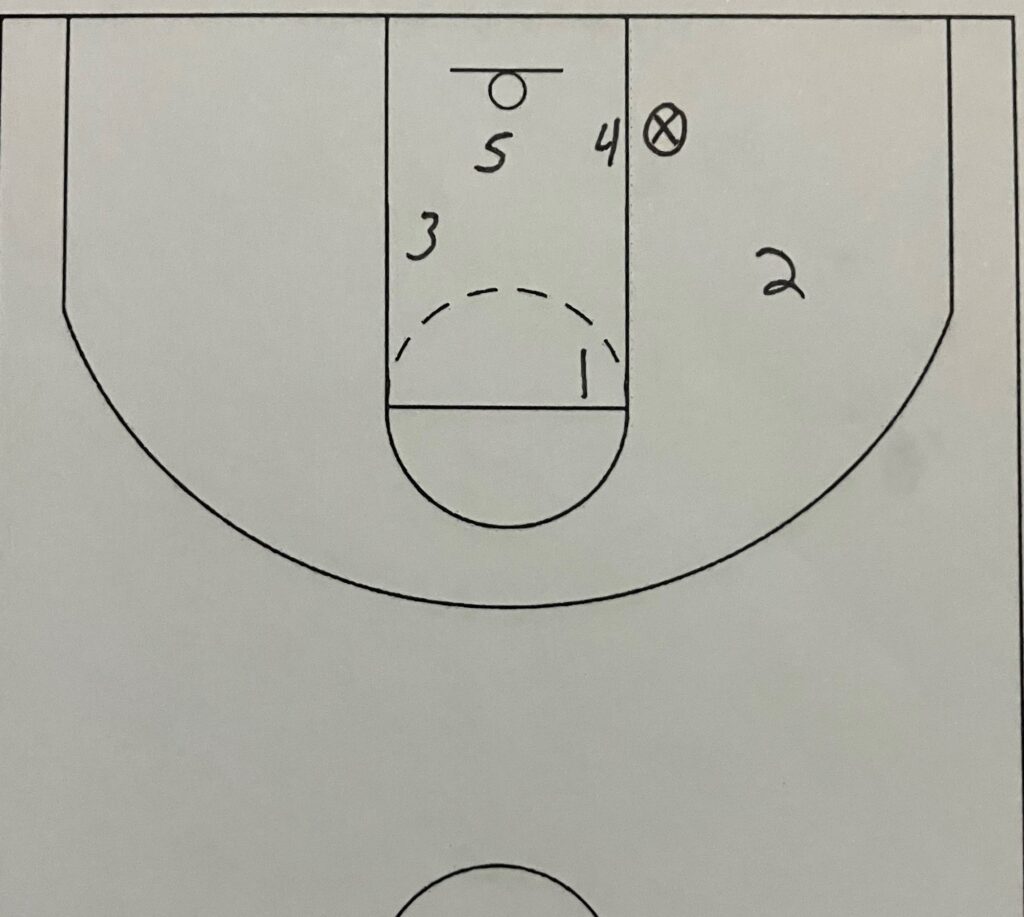
If the ball enters these spots right out of the initial setup this is the look of the defense. The high post is major problem #1. No defender is between the offensive player and the basket. Usually every defender will collapse which opens up everything on the outside.
Or nobody steps up and guards the ball because every player is thinking somebody else will guard the ball and the offensive player will get a wide open layup or jump shot. The 1-2-2 zone must keep the ball out of the high post area.
If the ball enters the low post straight from the start, this is the look. The point(1) is covering the high post. The ballside wing(2 or 3) steps out for the kick out. The backside wing drops. The ballside big(4 or 5) guards the ball. The backside big is stepping over for the possible help. This all changes with a post entry.


The rotations here are the same for the other side just with the wings and bigs reversed. On the wing entry, picture on the left, the backside big(5) is behind the post. The ballside big(4) is either collapsing or playing the kick out to the corner. The ballside wing(2) is guarding the passer. The backside wing(3) is covering the backside block. The point(1) is covering the high post.
On the corner entry, the right picture, the 1-2-2 zone has the same basic formation. The ballside big(5) is guarding the passer. The backside big(4) is guarding the post. The ballside wing(3) is either collapsing or guarding the wing kick out. The backside wing(2) is covering the backside block. The point(1) is covering the high post.
The 1-2-2 zone is nice in that the wing and corner ball positions does not change a lot of the rotations for the defense. Each defender has on the ball defensive responsibility which is nice for the development of each player. The problem is the high post and backside wing dropping and rebounding. As a coach, the difficulty with the 1-2-2 zone is not the teaching. The 1-2-2 zone is not difficult to teach. The problem is the ability of the team to execute and rotate quickly enough for the 1-2-2 zone to be effective.
Trapping in a 1-2-2 Zone
There are two main trapping areas in a 1-2-2 zone. This gives an advantage to the 1-2-2 zone over the 2-3 zone because of the natural positioning of the 1-2-2 zone to trap. The two trapping areas are the corners and the spot between the top of the key and the wing.
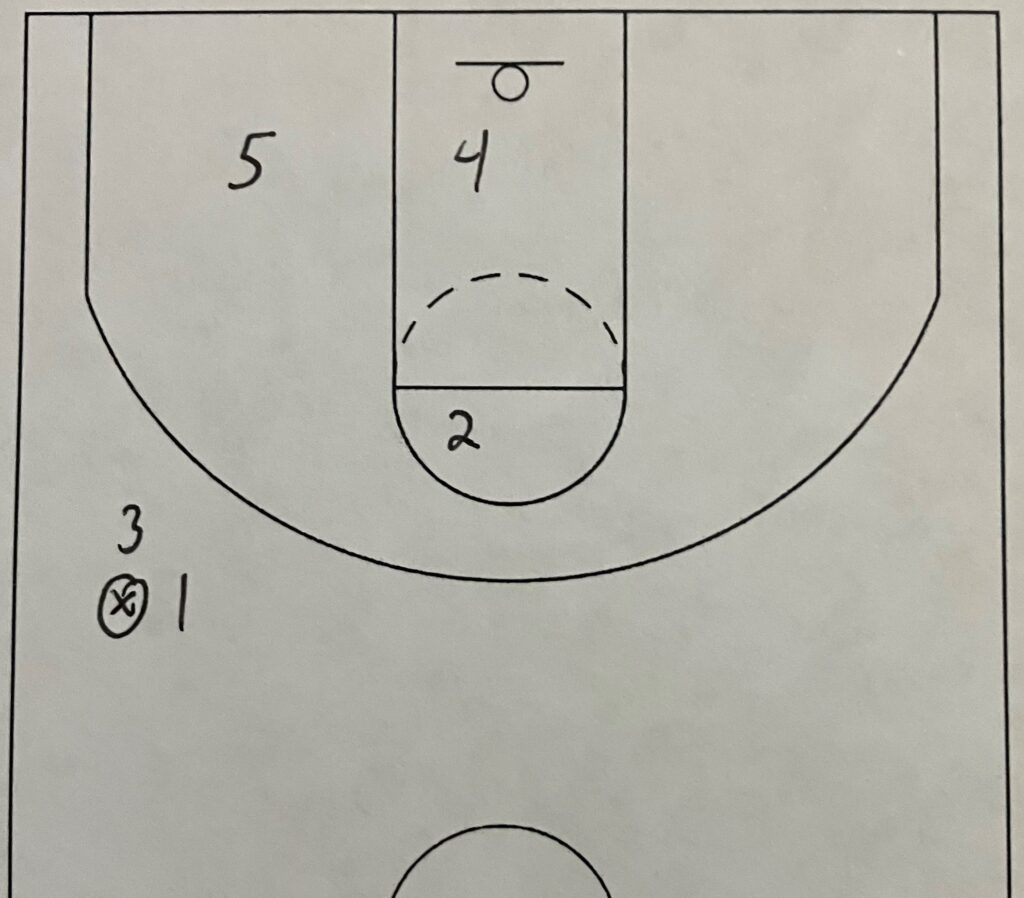
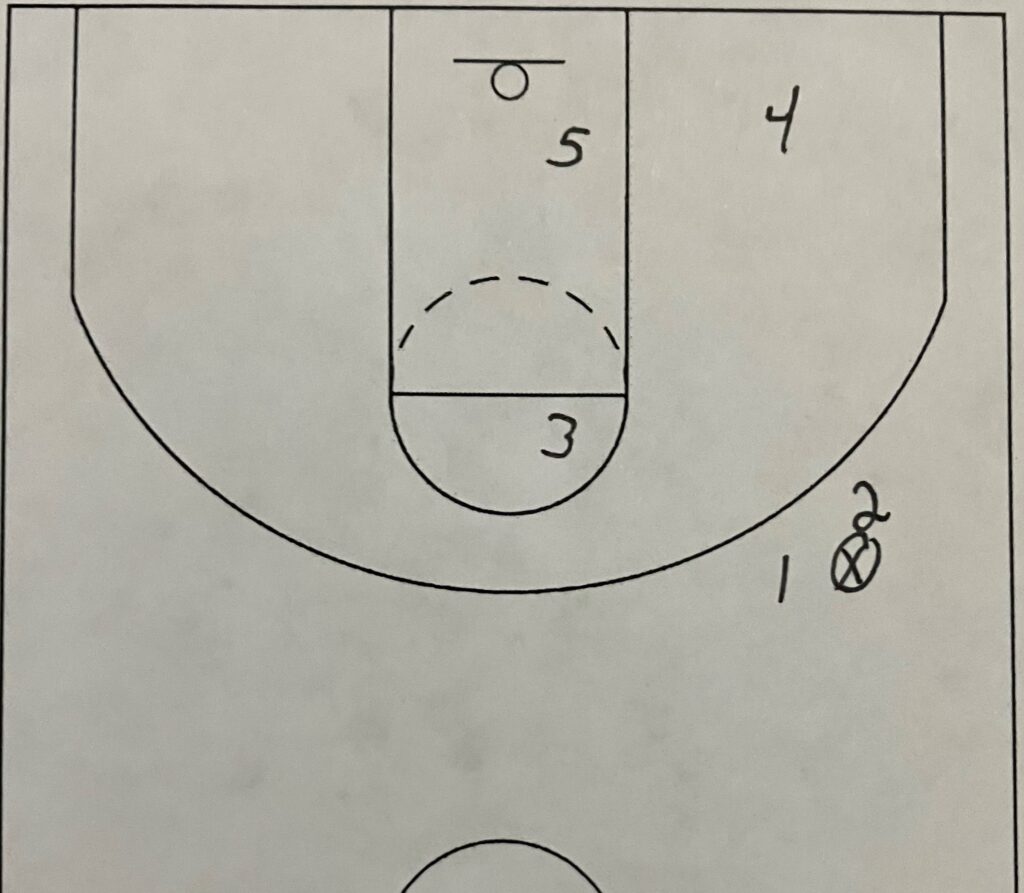
At the top of the zone, the trap is going to be done with the point(1) and ballside wing(2 or 3). The backside wing is covering the high post. The ballside big(4 or 5) is stepping out looking for any pass from the trap coming down the sideline. The backside big is covering the block to front of rim. The backside wing and big are looking for any skip pass coming out of the trap.
In an aggressive trapping 1-2-2 zone the backside wing can push up looking for a reversal pass steal. The backside big can push up with the wing covering the high post. This leaves the diagonal skip pass open. If the trap is good, then that diagonal skip would be really difficult to make. The only problem is that if the diagonal pass is made then it is an easy layup for the offense.

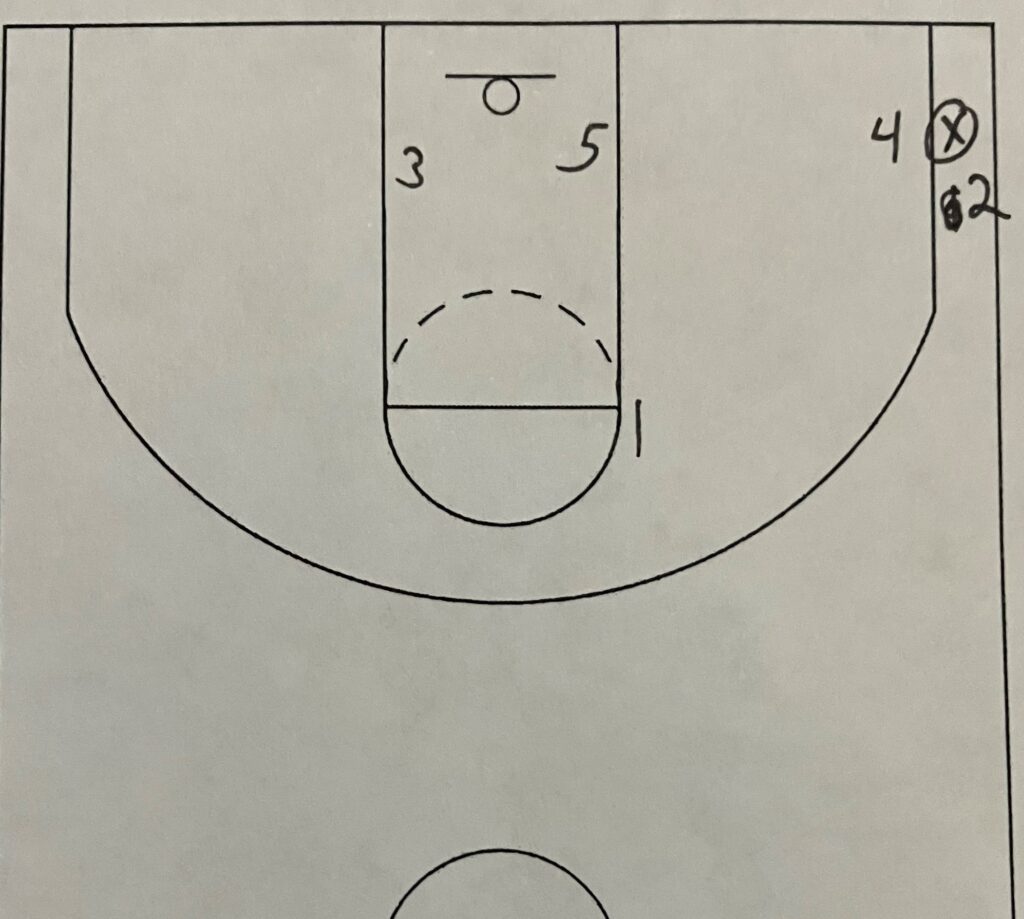
The 2nd trapping spot is in the corner. The ballside big(4 or 5) is guarding the ball as normal. The ballside wing(2 or 3) is coming down from the wing to trap the corner. The point(1) is covering the high post or wing area depending on team philosophy and chance for a steal. The backside big is covering the ballside block. And the backside wing is covering the backside.
In an aggressive 1-2-2 zone trapping defense the point(1) can shift towards the sideline looking for the pass coming up the sideline out of the trap. The backside wing can come up to the foul line. This aggressive style puts all five defenders on the same side of the court. It leaves no defenders on the backside. This gives the defense a great chance for a steal but if the ball is able to be skipped or reversed with speed then the offense has the ability to attack. The defense is going to be scrambling to rotate to the backside to prevent an easy basket.
Personnel Needed for a 1-2-2 Zone
I am under the assumption that most coaches are going to play either a 2-3 zone or 1-3-1 zone. Where the 1-2-2 zone comes into the conversation is when the players do not fit either of those zone defenses. Once the 2-3 zone and 1-3-1 zone are decided against then the 1-2-2 zone is looked at. So, these are the two situations that normally occur for the 1-2-2 zone to be an option.
The first occurrence is when the team has two bigs. The coach wants to keep the two bigs both around the basket and the 2-3 zone and 1-3-1 zone is going to move one of the bigs away from the basket. Moving a big away from the basket gives the offense a chance to stay on one side and basically eliminate one of the bigs from defense. By moving to a 1-2-2 zone, the two bigs are both going to be around the basket all the time.
The 2nd occurrence is when a team has length, so they are wanting to extend their defense. But a 1-3-1 zone requires a quick guard to run the bottom spot and they do not have a quick enough player to run corner to corner on the baseline. Because of not having this fast player, the switch to the 1-2-2 zone gives the team the same basic advantages of having length without needing to have that fast player. The length can still extend out away from the basket and still be able to guard the entire half court.
Keys of a 1-2-2 Zone
1) Keeping the ball out of the high post area
In any zone the high post area is a spot on the floor the defense needs to keep the ball out of. With the 1-2-2 zone, the offense has more space to use to get the ball into the high post area because there is not a defender strictly assigned to that area. If the offense can get the ball into this area, then the 1-2-2 zone breaks down quickly. This area of the floor is of the upmost importance for the defense to be successful.
2) Rebounding
Usually one of the main reasons a team starts playing the 1-2-2 zone is having two bigs. The team will be relying on these two bigs for a lot of the rebounding in the zone. If a team does not rebound out of any zone, then a change must be made.
The other big key in rebounding is having the two wings drop on the backside and still rebound in this backside position. The two wings in this defense must drop on the backside and rebound or the offense will get a bunch of backside putbacks. So, the two bigs must rebound but the defensive team must also have two guards willing to drop down to the block and box out and rebound.
3) Contesting all outside shots
The middle of the defense is open but by leaving the middle open the defense must contest all outside shots. This is the give and take of the defense. The middle stays open but outside shooters should never have an open shot unless the ball gets into the middle of the defense. An offensive team that runs a 5-out offense is a good time to use a 1-2-2 zone defense.
The other time to play the 1-2-2 zone is playing against a team that is looking to shoot a bunch of 3’s. The 1-2-2 zone stays spread out so the ability to closeout on the shooters should be much easier than a lot of other defenses.
Youth Basketball
The benefit of the 1-2-2 zone is getting to the outside shooters. At the youth level, this should not be much of a problem. Even though the main benefit of the zone does not apply much at the youth level, I like this defense more than the 2-3 zone or 1-3-1 zone as a primary defense. The fundamentals of defense still must be taught in the 1-2-2 zone. Every player will be required to be in every defensive position. Every player will guard the ball at times. Every player will be defending one pass away. And every defender will be in a helpside position. The fundamentals of basic man defense are being taught in this zone. And every player will use those fundamentals.
Conclusion
The 1-2-2 zone is a defense better used at the youth level as a primary zone defense. At the high school level, the 1-2-2 zone gives up to much space at the foul line and most teams will be able to get the ball into this area which causes a bunch of problems for the 1-2-2 zone.
On a strictly success basis the 2-3 zone or 1-3-1 zone will be more successful at the youth level but the players will not become better defenders. A 1-2-2 zone will develop players to a higher level as they grow because the fundamentals of defense will be used. In a 2-3 zone or 1-3-1 zone certain players will not be required to learn to guard the ball, and this will put the player farther behind their teammates as they get older.
If you are a coach wanting to win, then pick the 2-3 zone or 1-3-1 zone at the youth level. If you are a coach wanting to teach a zone while still helping to develop players, then the 1-2-2 zone might be the best zone defense to teach.

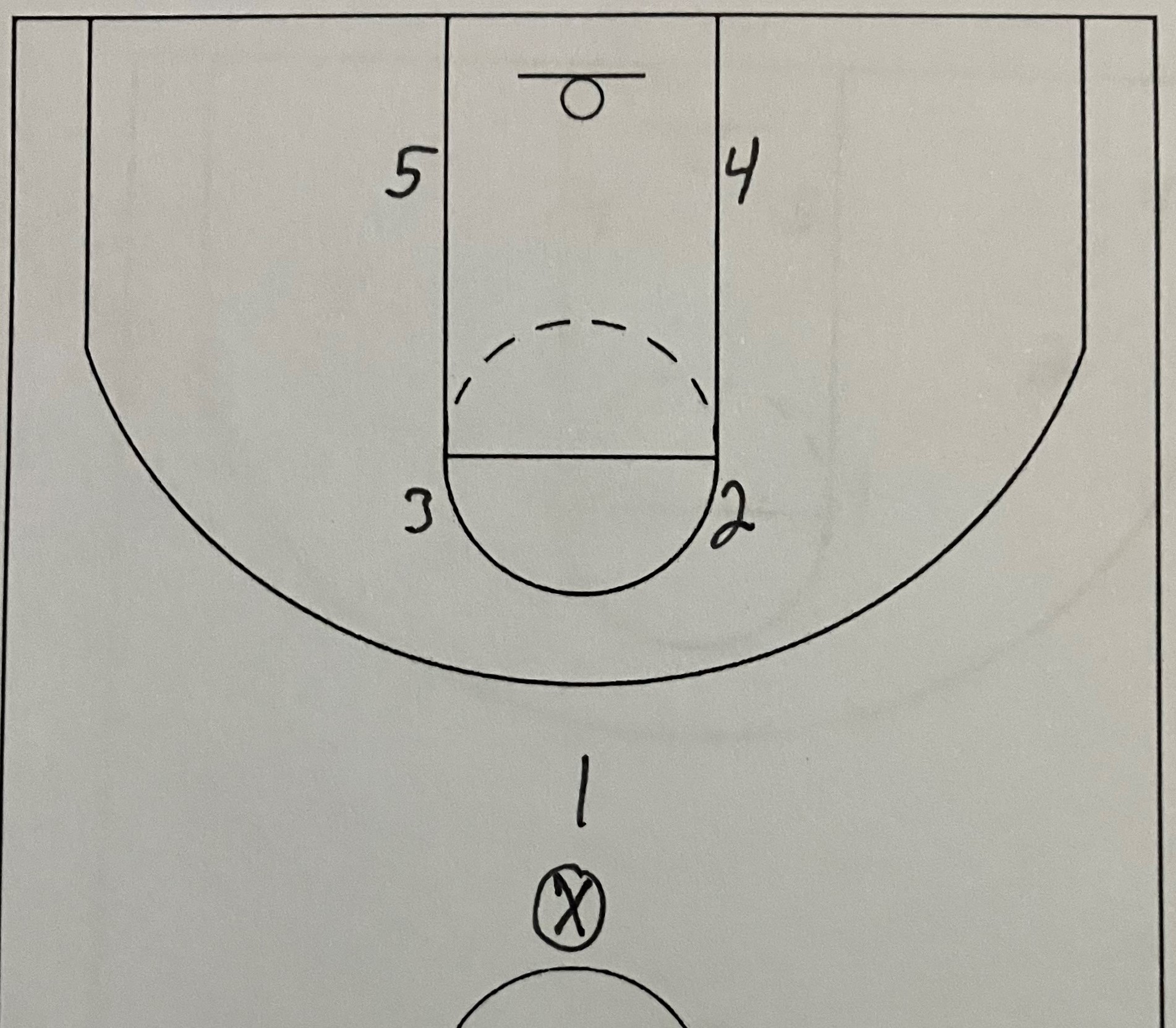
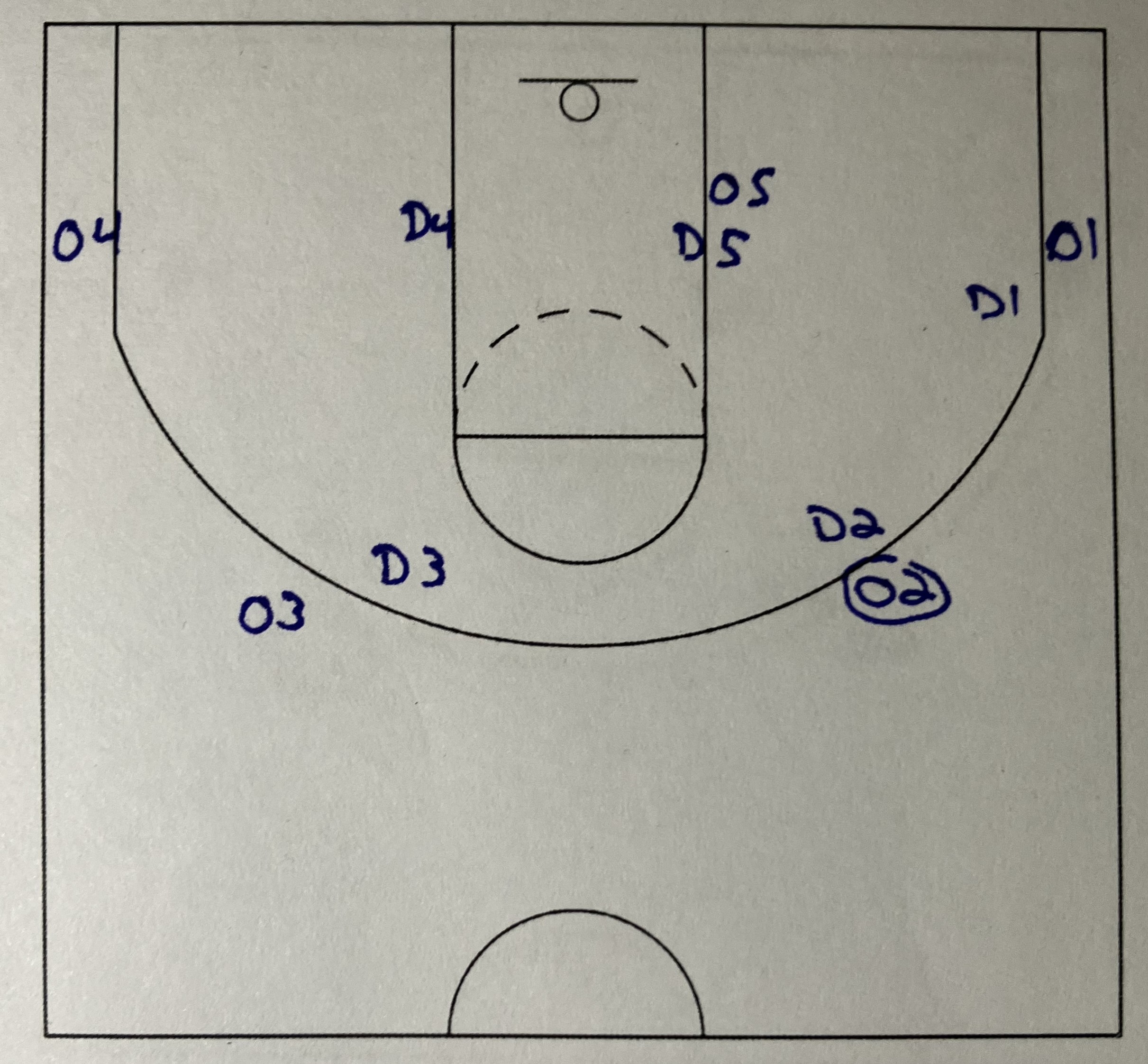
6 thoughts on “1-2-2 Zone Defense Guide”